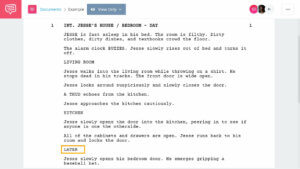
Usually indicated at the end of a Slugline as (SAME). If diving into the action might be disorienting, a brief establishing shot may be used.
Establishing shot slugline movie#
Maybe an indication of where the film will take place. A scene written into a movie or television episode to give the audience an idea of where they are. It’s starts as a wide shot, pushing in, taking the audience on a ride through the mountains. So then let’s take a look at the opening shot in Kubrick’s The Shining. The iconic director, Stanley Kubrick has a habit of twisting and turning the audience's minds faster than they realize it's happening.

They still establish location and tone, but in a way that’s a bit. There are some filmmakers that use the establishing shot in unique ways. Learn more about Wes Anderson's directing style. This consistency is inherent in each shot choice Wes Anderson makes. Show the scenes intercut together by writing the word INTERCUT, all in capital letters, at the top left of the intercut section. Make sure to describe whether it is an interior or exterior shot and day or night. In the video above, we have a completely different establishing shot example from The Grand Budapest Hotel, that sticks to this tone. Follow these steps to add an intercut to your own script: Write the slugline for each location. It matches the film’s fun and lighthearted tone. This shot is both ridiculous and humorous. Which brings me to the second thing this shot does… With a wide, high angle, we see the two men, their relation to each other, and their relation to the rest of the ridiculously sized, and otherwise, completely empty room.

We are introduced to where we are in the scene - the hotel’s dining room. Set up your scene with a script in which you indicate INT for interior or EXT. First, it establishes geography and location. Describe writing the writing of a good establishing shot in a screenplay.


 0 kommentar(er)
0 kommentar(er)
